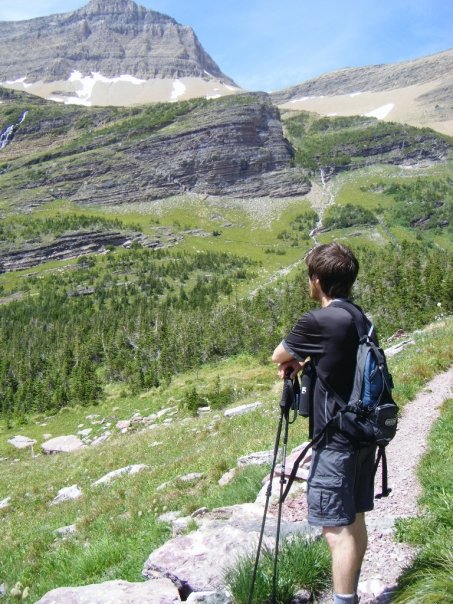Learn the benefits of antishock trekking poles with comparisons of Black Diamond Trail Shock and Black Diamond Contour Elliptic antishock hiking poles.
I received an email the other day asking for more info on Black Diamond Antishock Trekking Poles.
Specifically, this reader wanted to know the difference between Black Diamond Trail Shock Trekking Pole and Black Diamond Contour Elliptic Shock Trekking Poles.
I finished the email and then thought–wait, why not share this with all our readers? It’s valuable information, right?
So, here’s a copy of the email, my response, and what my thoughts are on the difference between Black Diamond Antishock Trekking Poles:
Antishock Trekking Poles
Reviews & Ratings
You have a great site. We’ve hiked Glacier Park at least 3 times and will hike Mt. Whitney this summer. Getting older (knees, but I’m still running 3 miles daily) so looking at trekking poles.
I really appreciate your review of Black Diamond trekking poles and the recommendation for the “Trail” model.
May I ask some other questions:
 |
1. What, if anything, does the Contour Shock add that makes it so much more expensive than the Trail Shock?
2. It seems the Black Diamond shock does not – at least initially – make a clicking sound. Does it get noisy with extended use?
3. Does the addition of the shock shorten the useful life of the pole?
4. Any other thoughts?
Thanks. I know this might beyond what you intended when you invited comments, but I really appreciate any time and consideration you may give.
Take care,
Loyal Reader (name removed for privacy sake)
Answer
Hi Loyal Reader,
Hiked Glacier at least 3 times, eh? Lucky you! Most people aren’t lucky enough (or smart enough) to get out there even once, let alone 3 times 🙂
Please keep in mind that I don’t know everything about antishock trekking poles–I’m just an avid outdoorsman that has owned lots of camping/hiking gear and use my knowledge of gear, terrain etc. to come to sensible conclusions about things.
But, I’ll do my best to answer your questions:
1. What, if anything, does the Contour Shock add that makes it so much more expensive than the Trail Shock?
Answer: To be honest, I don’t see any difference besides weight and size, both of which are in the Trail Shock’s favor.
—
2. It seems the Black Diamond shock does not – at least initially – make a clicking sound. Does it get noisy with extended use?

Answer: I haven’t used Black Diamond trekking poles (I own these Komperdell Hiking Poles![]() ), but I don’t see anything about clicking noises in reviews.
), but I don’t see anything about clicking noises in reviews.
They will probably click when you adjust the height and ‘snap’ the adjustment back in place but that’s it.
—
3. Does the addition of the shock shorten the useful life of the pole?
Answer: Probably. When you have non-shock poles, the only parts that can break are the height adjustment and grip.
The anti-shock adds another aspect to the trekking pole that can potentially break it.
That said though, I don’t think that should deter you.
You buy antishock trekking poles for two reasons:
- Stability
- To take the weight off your knees. The anti shock helps take the weight off. It’s a worthwhile investment, even if it cuts the lifespan down a year or two (which is all hypothetical anyway).
Besides, it’s better to have a hiking pole with a shorter lifespan than knees with a shorter lifespan, right? (Learn more about choosing the best trekking poles with this article)
It’s more likely that the pole will snag on something a few years down the line and snap.
If that’s the case, you bring it back to REI and take advantage of their 100% customer satisfaction guarantee and get a new one for free.
4. Any other thoughts?
Answer: I love trekking poles. I could never hike without them now.
You’re getting older. Your knees need help. Go with antishock trekking poles.
You won’t notice any difference going uphill or on flat land, but going downhill your knees will thank you many times over.
When comparing the Black Diamond Trail Shock and Black Diamond Elliptical Shock, I recommend the Trail Shock.
Why? It’s lighter. Think about carrying 4 ounces on each of your hands for 2-5 hours. It may not seem like much, but it will add up quickly and your hands will get tired.
Looking for the best price on Black Diamond antishock trekking poles?
Black Diamond Trail Shock![]() can be found here at REI
can be found here at REI
Or…
If price was the biggest deterrent from the Contour Elliptic…
You can buy Black Diamond Contour Elliptic![]() at REI Outlet for less than $90.
at REI Outlet for less than $90.
Or you can just head back to Trekking Pole Reviews from Antishock Trekking Poles
Or return to more info on Glacier National Park Hiking











i don’t understand how “anti-shock” trekking poles take more weight off your knees than trekking poles without the anti-shock feature… how could shock absorption connected to your hands and arms effect your knees?
Hi Austin,
Great question! The key with trekking poles is to time it so that the pole hits the ground right before your foot. While that might sound wayyy too complex for hiking, the truth is it’s really easy to get into a rhythm. Once you’re in a rhythm, it’s a breeze!
The anti-shock trekking poles absorb the shock so that when your feet hit the ground, there’s less shock on your knees. They take the brunt of the force.
They essentially act as an extra set of knees, but spare your knees the pain and shock of hitting the ground. While it might sound minor, it adds up after a while!